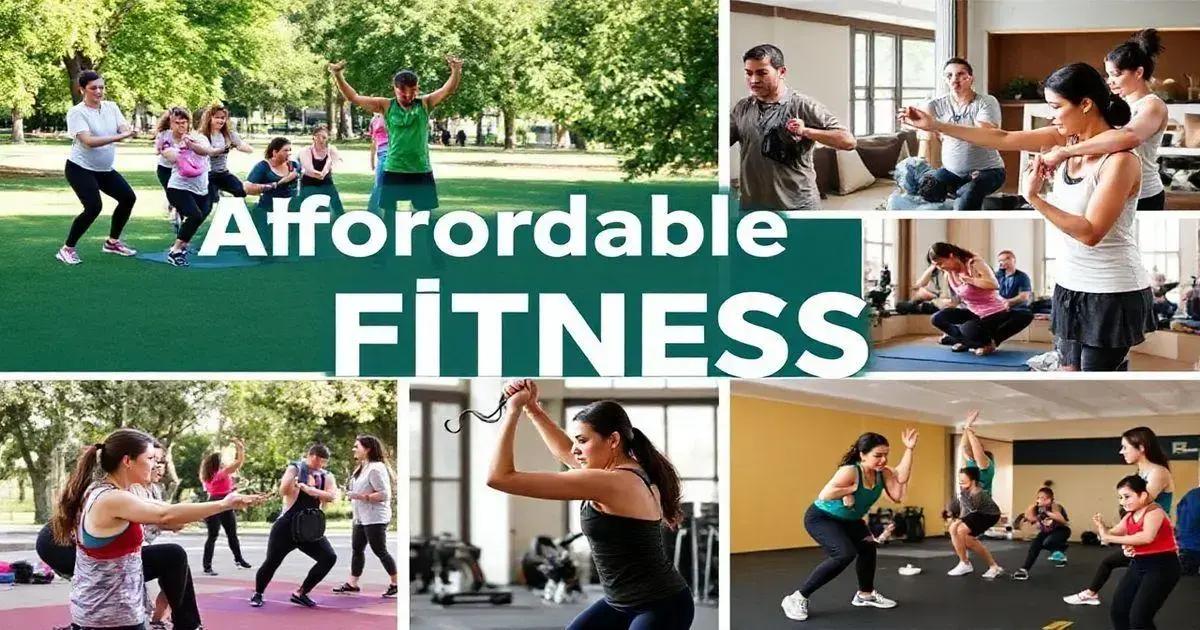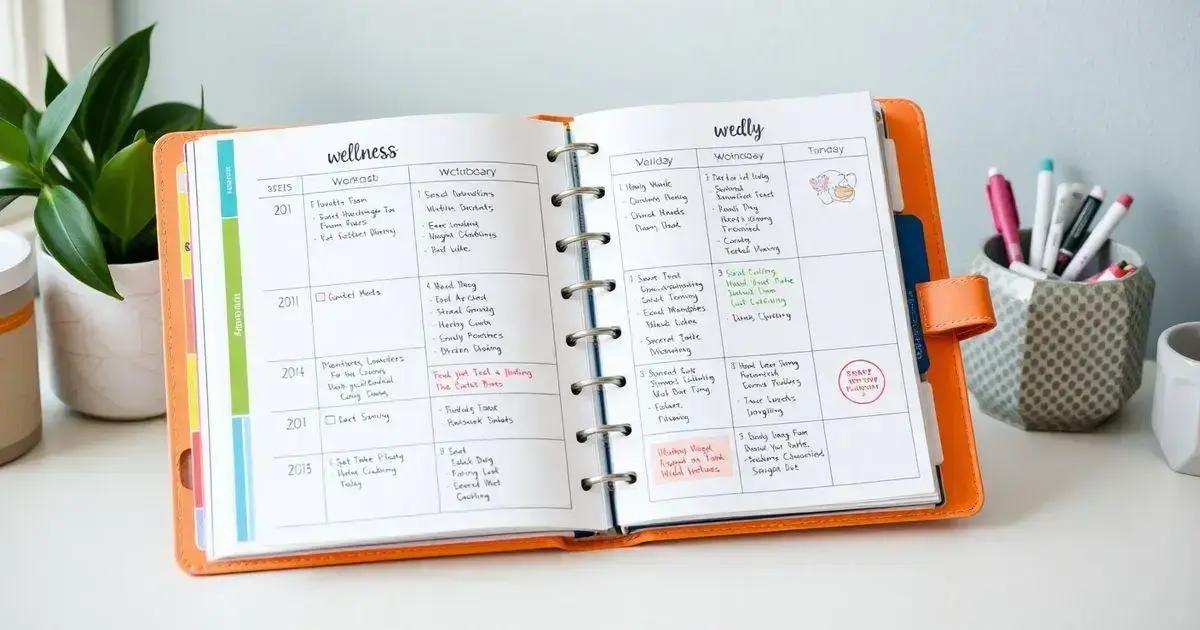How to Make a Budget-Friendly Wellness Plan: Strategies for You
How to make a budget-friendly wellness plan starts with simple steps. Prioritize what truly matters to your well-being, whether it’s exercise, nutrition, or mental health.
You don’t need to spend a lot to stay healthy. Simple routines and healthy habits can make a big difference without breaking the bank.
Want to dive deeper into building your own plan? Keep reading for practical tips and advice on how to maintain wellness affordably!
Understanding Wellness and Its Importance
Understanding wellness is about recognizing its significance in our lives. Wellness goes beyond just physical health; it includes mental, emotional, and social well-being. Embracing a holistic approach to wellness enables individuals to lead balanced and fulfilling lives.
The Dimensions of Wellness
Wellness can be broken down into several key dimensions: physical, mental, emotional, social, spiritual, and environmental. Each dimension contributes to our overall health. Engaging in activities that promote all these areas helps create a stable wellness journey.
Physical Wellness
Physical wellness involves taking care of your body through proper nutrition, exercise, and getting enough rest. It helps reduce the risk of chronic diseases and fosters a higher energy level.
Mental and Emotional Wellness
Mental wellness focuses on our ability to cope with stress, make decisions, and solve problems. Emotional wellness is about understanding and managing your feelings. Both are essential for a healthy lifestyle.
Social Wellness
Social wellness encourages developing healthy relationships with others. Connecting with family, friends, and community helps to create a support system, which is vital for overall wellness.
Spiritual and Environmental Wellness
Spiritual wellness is about finding purpose and meaning in life. Environmental wellness emphasizes the importance of living in harmony with our surroundings. Both contribute to a well-rounded sense of well-being.
Why Wellness Matters
Recognizing the importance of wellness helps us make informed choices that improve our quality of life. Incorporating wellness practices into our daily routine can lead to greater happiness, reduced stress, and a longer, healthier life.
Understanding these aspects of wellness can serve as the foundation for how to make a budget-friendly wellness plan, ensuring it addresses both our physical and mental health needs while remaining cost-effective.
Assessing Your Current Lifestyle
To create a budget-friendly wellness plan, the first step is assessing your current lifestyle. This process helps you understand your habits and identify areas you can improve. Start by taking an honest look at your daily routine.
Evaluate Your Daily Activities
Write down your daily activities, including work, chores, meals, and leisure time. Consider how much time you spend in front of screens versus engaging in physical activities. This will show where you can make adjustments.
Analyze Your Eating Habits
Your diet plays a major role in your overall wellness. Keep a food diary for a week to monitor what you eat and drink. Look for patterns, such as high consumption of junk food or skipping meals. This analysis will help you identify areas for improvement.
Assess Your Exercise Routine
Next, consider how often you exercise. Are you keeping active regularly, or do you find it difficult to incorporate physical activity into your routine? Aim for at least 150 minutes of moderate exercise each week. Make a note of what type of exercise you enjoy to help you stay motivated.
Reflect on Your Mental Health
Mental wellness is crucial for overall well-being. Take time to reflect on your stress levels and coping strategies. Are there sources of stress you can manage better? Consider practices like meditation or journaling to support mental health.
Examine Your Social Life
Evaluate the quality of your relationships. Are you connecting enough with family and friends? Strong social ties contribute significantly to overall wellness. If you find you’re lacking in this area, think about ways to strengthen your connections.
Identify Areas for Improvement
Based on your assessments, highlight the areas where changes are needed. Be specific about what you want to improve and set small, achievable goals. This approach will help make the changes feel more manageable.
By thoroughly understanding your current lifestyle, you can lay the foundation for a successful budget-friendly wellness plan. Recognizing your strengths and weaknesses allows you to make informed decisions about your health journey.
Setting Realistic Wellness Goals
Setting realistic wellness goals is essential for success in your wellness journey. Goals give you direction and help you stay focused. However, they must be attainable to be effective.
Make Your Goals Specific
Start by being specific about what you want to achieve. Instead of saying, “I want to be healthier,” try defining your goal, such as “I want to exercise for 30 minutes three times a week.” This clarity makes it easier to create a plan.
Use the SMART Criteria
Adopting the SMART criteria helps you set effective goals:
- Specific: Be clear about what you want to accomplish.
- Measurable: Establish a way to track your progress.
- Attainable: Ensure your goals are realistic and achievable.
- Relevant: Goals should align with your overall wellness journey.
- Time-bound: Set a deadline to create a sense of urgency.
Break Goals into Manageable Steps
Large goals can feel overwhelming. Instead, break them down into smaller, manageable steps. For instance, if your goal is to run a marathon, start with a plan that includes walking, then jogging, and eventually running short distances.
Stay Flexible and Adjust Goals as Needed
Circumstances can change, and that’s okay. If you find that certain goals aren’t working for you or if life gets busy, don’t hesitate to adjust them. Flexibility helps you stay committed without feeling discouraged.
Celebrate Your Progress
Recognizing and celebrating your achievements, no matter how small, is vital. Acknowledging your progress helps to maintain motivation. Consider rewarding yourself with non-food-related treats, like a spa day or new workout gear.
By setting realistic wellness goals, you create a clear path to achieving your wellness plan while ensuring your efforts align with your lifestyle and capabilities.
Identifying Budget-Friendly Activities

Identifying budget-friendly activities is essential for maintaining wellness without overspending. Many activities promote health and happiness, but they don’t have to cost a lot of money.
When figuring out how to make a budget-friendly wellness plan, it’s important to include activities that won’t strain your finances. Here are some ideas to get you started.
Explore Nature
Outdoor activities such as hiking, biking, or walking in the park are great for both physical and mental wellness. They are usually free and provide a chance to enjoy nature and fresh air.
Join Community Classes
Many communities offer free or low-cost classes in yoga, dance, or other fitness programs. Check local community centers or libraries for schedules. Participating in these activities is a fun way to meet new people and stay active.
Utilize Home Workouts
You don’t have to pay for a gym membership to get fit. Many online platforms offer free workout videos ranging from yoga to high-intensity interval training (HIIT). Create a home workout routine that fits your schedule.
Practice Mindfulness
Mindfulness techniques, such as meditation and deep breathing exercises, can enhance mental health without any cost. Find quiet space at home or use free apps for guided sessions.
Volunteer for Physical Activities
Volunteering for local charity events or organizations often involves physical activity, like running races or helping in community gardens. It’s a rewarding way to stay active while contributing to your community.
Organize Group Activities
Gather friends or family for budget-friendly activities like potlucks, game nights, or group workouts. Sharing experiences with others can boost motivation and make activities more enjoyable.
Combine Errands with Fitness
Instead of driving, walk or bike to run errands when possible. This not only saves money on gas but also helps you incorporate physical activity into your daily routine.
By identifying budget-friendly activities, you can enhance your wellness plan without straining your finances. These tips can show you how to make a budget-friendly wellness plan that fits your lifestyle, proving that staying well doesn’t have to be expensive.
Incorporating Healthy Eating on a Budget
Incorporating healthy eating on a budget is possible with a little planning and creativity. You don’t have to spend a fortune to nourish your body.
When you’re figuring out how to make a budget-friendly wellness plan, healthy eating can be an essential part of your approach. Here are some practical tips to help you maintain a healthy diet without breaking the bank.
Plan Your Meals
Starting with a meal plan is an effective way to control your food budget. Take time each week to plan breakfast, lunch, and dinner. Create a list of ingredients needed for your meals to avoid impulse buying.
Make a Shopping List
Once you have your meal plan, make a shopping list and stick to it while at the store. This helps prevent unnecessary purchases and helps you focus on items that contribute to your healthy eating goals.
Buy in Bulk
Consider buying staple foods like rice, beans, and oats in bulk. These options are often cheaper and can be used in various recipes throughout the week. Ensure they have a long shelf life to avoid waste.
Choose Seasonal Produce
Fruits and vegetables that are in season tend to be cheaper and tastier. Visit local farmers’ markets or grocery stores and look for deals on fresh produce. Incorporating these into your meals can enhance flavor and nutrition.
Cook at Home
Preparing meals at home is a great way to save money and control ingredients. Experiment with simple recipes that use basic ingredients. Cooking meals in larger batches can provide leftovers for lunches and save time and effort.
Limit Processed Foods
Processed foods may be convenient, but they often cost more and contain unhealthy additives. Focus on whole foods like fruits, vegetables, lean proteins, and whole grains, which are not only healthier but also more affordable in the long run.
Utilize Leftovers
Don’t let leftovers go to waste! Get creative by transforming them into new meals. For example, leftover roasted vegetables can be added to soups or salads, turning them into a quick and healthy dish.
By incorporating these tips, you can successfully combine healthy eating habits with a budget-friendly approach. If you’re wondering how to make a budget-friendly wellness plan, these food strategies are essential in keeping your overall wellness within reach.
Finding Affordable Fitness Options

Finding affordable fitness options is vital for maintaining a healthy lifestyle without overextending your budget. If you’re wondering how to make a budget-friendly wellness plan, focusing on low-cost fitness options can be a great place to start. Here are some ways to stay active without spending a lot of money:
Explore Community Resources
Many communities offer free or low-cost fitness programs. Local parks and recreation departments may have workout classes, sports leagues, or even access to fitness equipment. Check out what’s available in your area.
Utilize Public Spaces
Parks provide excellent venues for exercise. You can walk, jog, or bike along trails or participate in group fitness events that are often offered for free. Make use of playgrounds for body-weight exercises like push-ups or pull-ups.
Take Advantage of Online Resources
The internet is full of free exercise videos and workout plans. Platforms like YouTube feature trainers who offer everything from yoga to strength training sessions you can do at home without any equipment.
Join Local Meetup Groups
Look for local fitness groups or clubs. Many meetups are free or require minimal fees. This is a great way to meet new people and stay motivated while exercising together.
Invest in a Second-Hand Gym Membership
Consider purchasing a second-hand gym membership or a discounted pass. Many gyms offer promotional deals or allow you to use a friend’s guest pass. This can save you money while still providing access to fitness facilities.
Participate in Fitness Challenges
Many communities and online platforms host fitness challenges that are free to join. These challenges can be fun and motivating, encouraging you to stick to your routine while connecting with others who share your goals.
Use Home Workout Equipment
If you have basic equipment like dumbbells or resistance bands, you can easily create a workout routine. Look for free online classes that utilize minimal equipment or no equipment at all.
By exploring these affordable fitness options, you can keep your body moving and stay healthy without emptying your wallet. If you’re figuring out how to make a budget-friendly wellness plan, incorporating these fitness strategies will help you stay on track.
Exploring Free Mental Health Resources
Exploring free mental health resources is important for maintaining emotional well-being. Many organizations and services provide support without any cost. When considering how to make a budget-friendly wellness plan, utilizing these free resources can be a great starting point. Here are several accessible options to consider:
Community Mental Health Centers
Most communities have mental health centers offering free or low-cost services. These centers often provide counseling, therapy, and support groups for individuals facing various mental health issues.
Hotlines for Immediate Support
Many hotlines are available for immediate assistance. The National Suicide Prevention Lifeline offers 24/7 support, and local helplines can help with mental health emergencies. These services can provide someone to talk to when you need immediate help.
Online Support Groups
Online forums and support groups can provide a sense of community. Websites like 7 Cups and Mental Health America offer various resources, including discussing experiences with others who understand.
Mobile Apps for Mental Health
Several mental health apps are available for free, offering tools for stress management, meditation, and mood tracking. Apps like Calm, Headspace, and Moodfit can help you integrate mental wellness practices into your daily life.
University Counseling Services
If you are a student, many universities provide free counseling services. These may include individual therapy, group therapy, and workshops on stress management and anxiety reduction.
Public Libraries
Many public libraries offer free access to mental health resources, including books, workshops, and events focused on mental wellness. They may also provide information on local resources and programs.
Workplace Programs
Many employers offer Employee Assistance Programs (EAPs) that provide free counseling and mental health resources. Check with your HR department to learn about the services available to you.
Utilizing these free mental health resources can help improve your emotional well-being without financial stress. If you’re looking for how to make a budget-friendly wellness plan, these services can play a crucial role in supporting your mental health.
Creating a Wellness Schedule

Creating a wellness schedule is essential for organizing your activities and making time for self-care. A structured plan helps ensure you prioritize your health and well-being. Knowing how to make a budget-friendly wellness plan can make this process even more accessible. Here’s how to develop a practical wellness schedule:
Assess Your Current Routine
Start by evaluating your daily and weekly routines. Identify the time you currently spend on work, chores, and leisure activities. This will help you see where you can fit in wellness activities.
Set Clear Wellness Goals
Based on your wellness goals, decide what activities you want to include in your schedule. Goals such as exercising regularly, cooking healthy meals, and practicing mindfulness should be prioritized.
Designate Specific Times
Assign specific times for each wellness activity. For instance, you might choose to go for a walk every morning at 7:00 AM, have lunch at noon, and do a workout in the evening. Consistency will help you build healthy habits.
Include a Variety of Activities
Make sure your schedule includes a mix of physical activities, healthy eating, and mental wellness practices. For example, on one day you could plan a yoga class, while another day you might focus on meal prepping.
Plan for Flexibility
While it’s great to have a schedule, life can be unpredictable. Allow some flexibility in your wellness plan. If an activity needs to be changed or skipped, it’s okay to adjust and find another time.
Use a Calendar or Planner
Writing down your schedule in a calendar or planner can help keep you accountable. You can use a physical planner, or opt for digital calendars and apps that send reminders for planned activities.
Review and Adjust Regularly
Periodically review your wellness schedule to see what’s working and what’s not. Make adjustments as needed to ensure your schedule continues to fit your life and supports your wellness goals.
By creating a wellness schedule, you can manage your time effectively and commit to activities that enhance your well-being. This organized approach helps make wellness a priority in your daily life. Understanding how to make a budget-friendly wellness plan will help you stay on track without overextending your resources.
Tracking Your Progress Effectively
Tracking your progress effectively is crucial for understanding how well you are meeting your wellness goals. It helps you stay motivated and make necessary adjustments to your wellness plan.
Knowing how to make a budget-friendly wellness plan can help you stay on track without breaking the bank. Here are some strategies for tracking your progress:
Set Clear Metrics
Define what success looks like for each of your wellness goals. For example, if your goal is to eat healthier, metrics could include the number of fruits and vegetables consumed each week or the number of home-cooked meals prepared.
Keep a Journal
Writing in a wellness journal can help you track various aspects of your health journey. You can document meals, exercise routines, feelings, and daily reflections. This allows you to see patterns and understand how different activities affect your well-being.
Use Apps and Technology
There are many apps designed to help you track fitness, diet, and mental health. These apps often allow you to log activities, monitor progress, and even set reminders for workouts or mindfulness sessions. These tools can be part of your plan on how to make a budget-friendly wellness plan, as many are free or low-cost.
Take Regular Measurements
Keep track of relevant measurements such as weight, body measurements, or mood ratings. Regularly updating these metrics can help you see progress over time and maintain focus on your goals.
Schedule Progress Reviews
Set aside time each week or month to review your progress. Reflect on what you have achieved, where you struggled, and what changes you might want to make moving forward. This regular check-in can help reinforce commitment.
Celebrate Achievements
Recognizing and celebrating your accomplishments, whether big or small, is important. Celebrating progress can encourage you to keep moving forward and can be as simple as treating yourself to a relaxing activity or recognizing a milestone.
By tracking your progress effectively, you can stay motivated and focused on your wellness journey. This ongoing evaluation helps ensure that your actions align with your goals and supports your overall health.
FAQ – Frequently Asked Questions about Creating a Budget-Friendly Wellness Plan
What are the benefits of having a wellness plan?
A wellness plan helps you prioritize your health by setting clear goals, ensuring you make time for self-care, and tracking your progress.
How can I set realistic wellness goals?
Create SMART goals that are Specific, Measurable, Attainable, Relevant, and Time-bound to ensure they are achievable.
What are some budget-friendly activities to include in my wellness plan?
Consider outdoor activities, community classes, and home workouts, as well as utilizing public spaces and local resources.
How can I incorporate healthy eating on a budget?
Plan your meals, make a shopping list, buy in bulk, and focus on seasonal produce to save money while eating well.
What free mental health resources are available?
Look into community mental health centers, hotlines, online support groups, and university counseling services for accessible support.
How can I track my wellness progress effectively?
Use journals, apps, and regular check-ins to monitor your progress and adjust your plan as needed while celebrating your achievements.
